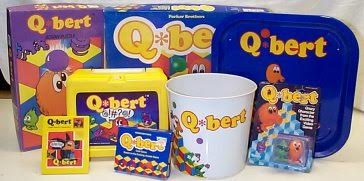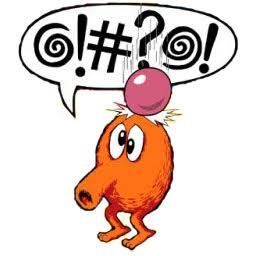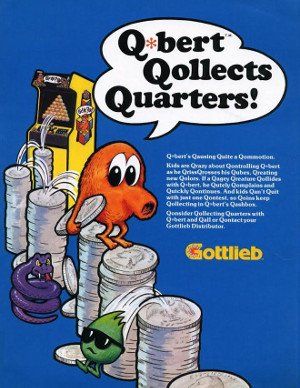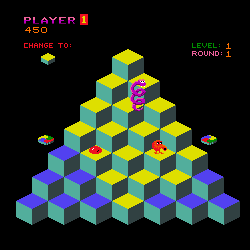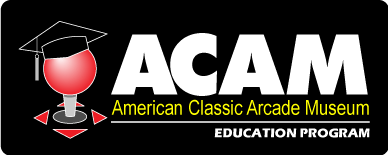Q-bert
Game History
Q*bert
Publisher/Manufacturer: GottliebDeveloper: Warren Davis & Jeff LeeRelease Year: 1982
By Mike Stulir • Vice President, The American Classic Arcade Museum
Gottlieb was a pinball manufacturer who briefly got into the videogame business. Founded by David Gottlieb in 1927, the company created pinball machines from 1931 through 1996.
Over a nine year period beginning in 1980, the company released eleven arcade video games & had another eight games in development that did not hit the market.
Of those games, the one big success was Q*Bert, an unusual and colorful game with creative characters that are still part of pop culture today.
Q*Bert arcade machine marquee.
Warren Davis
Warren Davis is a former arcade video game developer who worked at such manufacturers as Gottlieb & Midway.
Warren’s most popular game was Q*Bert,
a quirky & amusing game released by Gottlieb in 1982. Warren helped develop other popular arcade games as well including Joust 2, Revolution X featuring Aerosmith, Terminator 2 & Exterminator.
Warren’s laserdisc game, Us Vs. Them, is a popular attraction at ACAM, and attracts huge crowds when it has been on display at PAX-East in Boston.
Warren also developed the video digitizing technology used in such arcade games as the NBA Jam series and the Mortal Kombat series.
Recently, I spoke with Q*Bert, developer, Warren Davis, for the ACAM Education Program, and here is what he had to say about his creation…..
ACAM: Warren, can you tell us a little bit about your educational background?
Warren: I have a BS in Computer and Systems Engineering from Rensselaer Polytechnic University in Troy NY, and an MS in EE from Ohio State Univ.
ACAM: Prior to joining Gottlieb, you worked for Bell Labs. What kind of work were you doing there?
Warren: I was a tester for Operator Services, which was a group that would write new features into the system that telephone operators used, and I was part of the team that would travel to a phone company office somewhere in the country which would be a guinea pig for the new software and spend a few months testing that software. In-between those assignments, I was on loan to the R&D group, where I designed some pattern matching hardware for a speech recognition system. This was a long time ago - pretty advanced stuff then.
ACAM: You joined Gottlieb in 1982. Were you specifically looking to get into video games, or was it just a matter of looking for a new job? How did your previous employment history translate to programming video games?
"Remember that games are entertainment, but can also be art. Try to advance the art of what makes a game unique if you can. Also, it's great to have a vision for what you want to create, but don’t be afraid to experiment and fail. Failure is a key to larger success."
Warren: I was specifically interested in making video games. That's what Gottlieb's ad in the Sunday paper said. In fact, when I left Bell Labs, I thought I was done with engineering as a career. It was the notion of making games that brought me back into it. As for the second part of the question... it didn't at all. But as it turned out, there weren't that many experienced video game programmers in Chicago at the time, so Gottlieb was willing to take a chance on people.
ACAM: Gottlieb was known at that time as a pinball company & broke into video game development with Tim Skelly's Reactor. Since Gottlieb had no real experience in video games, I would have to assume you & the other video game developers were starting with nothing. What were some of the advantages and disadvantages of working in that type of environment?
Warren: The advantage was that we could invent the art form as we went along, and we were encouraged to do so. We also had the advantage of Tim Skelly's background and experience, and he served as a mentor to us. The disadvantage was that there was very little oversight from management initially, and some programmers floundered.
ACAM: My understanding is that your first project was assisting on a title that went by a number of different names during its development. I believe it is most commonly known as Argus or Protector. The game never made it beyond the testing stage. Not much has been made public about that game beyond that it was a superhero game played with a trackball. Can you describe the game and what your involvement was?
Warren: It was a super-hero game inspired by the Superman II movie which featured the 3 Kryptonian villains. We didn't have a license to use Superman, so the hero was a generic flying super-hero battling 3 equally powered super villains. The villains would knock the hero into buildings and rubble would fall to the ground crushing pedestrians walking on the street. I programmed a bulldozer that would occasionally come out and push the rubble off the screen.
Warren: The game evolved one piece at a time. First I saw a screen filled with the Escher pattern and imagined it as a pyramid of cubes. I saw that as an opportunity to teach myself randomness and gravity, so I implemented the pyramid and falling balls. The feedback from people was good so I added a player character who hopped from cube to cube. People began to suggest ideas, many of which were never taken seriously. But every now and then an idea seemed perfect. Ron Waxman, VP of engineering suggested the tops of the cubes changing color. Jeff Lee was an invaluable sounding board and came up with some great ideas that made it into the game. Dave Thiel came up with the idea of Q*bert's voice being random phonemes. Rick Tighe, one of our techs, had the idea to put a pinball knocker in the bottom of the cabinet. I of course inserted my own ideas as the game progressed and acted as the filter. Since I was the only programmer, no idea got in the game unless I liked it.
ACAM: You bring up a good point here with all of the people contributing ideas. I have had designers and programmers tell me that they like as few people involved with input as possible, and some say that a team approach with a lot of input works better. Can Q*Bert, be considered to be a “design by committee” type of game? Do you see "design by committee" as a good thing, or do you think that design by a single person was better for arcade games?
Warren: I think “design by committee” implies that there is no one person responsible for the vision of a game. This is different from having a single person in charge who accepts a lot of input. The “single auteur” method allows the person in charge to decide whether to accept or reject any ideas that come their way. Some auteurs may not like others suggesting things, and that’s certainly their prerogative. Q*Bert was not, as some have mistakenly reported, designed by committee. I was the game’s designer and project leader. However, I welcomed input from anyone who offered it, and felt free to reject it…which happened quite a lot. Since I was the sole programmer, it was up to me to implement any ideas and I was not shy about wanting to keep the game simple. This was both a practical and stylistic choice on my part. I think having a single person in charge who acts as a filter for ideas is the best way to create. I’m not a fan of design by committee because I think it tends to dilute a concept in trying to satisfy too many agendas. And a designer who rejects all input runs the risk of limiting creativity. Ideas from outside sources can bounce around and evolve into wonderful things that the person in charge may never have thought of by themselves. I liken it to a film director. They have a creative staff of talented people (cinematographer, art director, costumes, makeup, etc.), who can each bring their own ideas, shaped by the vision of the director. It’s a collaborative effort with a single guiding vision. That’s my ideal environment and I was fortunate in that the development of Q*Bert fit that description.
ACAM: Jeff Lee was known as quite the cartoonist. Can you discuss how his sketches and graphic design helped shape the game?
Warren: I liked the whimsical nature of Jeff’s characters. In retrospect, though, I have to admit that I would have taken any characters he gave me. What the characters looked like was less important to me as the game was being developed than how the game played, so I let him run with the character design. My recollection is that a few if not all of the characters were created by Jeff before I started programming the game. They were just things that he came up with on his own. The Q*bert character had a long nose because Jeff thought if it was ever used in a game, it could shoot snotballs out of its nose. That’s Jeff’s sense of humor, and while I liked and appreciated that humor, I nixed the shooting because it didn’t make sense in the context of the game I was creating. But there’s no doubt that Jeff’s character designs helped support the humor of the game and also the surreal nature of the world we were creating.
ACAM: Can you tell me how Faster Harder More Challenging Q*Bert came to be.
Warren: While developing Q*Bert, I would get feedback from other Gottlieb employees that it was too hard. When we had focus groups, or the game went on test in local arcades, people would sometimes have a hard time getting the hang of it. Management was concerned it might be too hard, so I tuned it to be easier. Once it was in production and hitting arcades around the country, word got back that while some people had a hard time mastering it, others were playing it for hours on a single quarter. I came to believe I’d make a mistake, and made it too easy. My response was to re-tune it closer to my original instincts. I took a few weeks and re-tweaked, shuffled the order of levels, added some new features that increased the difficulty, and we had something that was not a sequel, but essentially a re-tuned version. It went on test, but it was too soon. People were still getting the hang of the original Q*Bert. Management decided to scrap it. Why they didn’t just hold on to it, and release it in another 6 or 9 months is a mystery to me. In deciding what to name it, I didn’t like the idea of calling it Q*bert 2, or Super Q*bert. When people asked me what was different about it from the original, I found myself saying the same thing a lot, namely “Well, it’s faster, harder and more challenging.” And it struck me that that would make a very appropriate name for it. I held on to the ROMs and kept them in my Q*bert cabinet at home, and when I found out the MAME project had emulated Q*bert in the late 1990s, I released the ROMs to them.
ACAM: What were your thoughts on all of the merchandising? Back in the day, I seem to recall the Q*bert merchandise being as plentiful as the Pac-Man merchandise. Between the stuffed animal characters, the board game, the t-shirts, etc. Q*bert was everywhere. Did that take you by surprise?
Warren: It was a bit of a surprise how aggressively Gottlieb marketed it, but it wasn’t a surprise that they would try. I expected T-shirts, toys and board games, but I don’t think I ever expected a breakfast cereal or a Saturday morning cartoon. More than anything, I was surprised at the popularity of the character! For a year or two, Q*bert was everywhere.
ACAM: Q*bert was one of the top games with regards to return on investment for the arcade operator. In your opinion, what kept players consistently dropping quarters into the game?
Warren: I think it was a combination of a number of factors. The game mechanics were simple to learn, but could be difficult to master. I think people were challenged by that without being turned off. Plus, the game didn’t take itself too seriously. And the game had some unique features… its “3D” look, its surreal characters, the gravity inversion for Uggh and Wrong-way, the knock from the cabinet when Q*bert plummeted to his death, to name a few.
ACAM: I'd like to discuss the development tools that were at your disposal. Can you tell me about the Blue Box?
Warren: My memories of the Blue Box are sketchy, but I know there's information about it online - I would suggest that as a better source of information than me! I know it used a large floppy disk (8 inches!), and In-Circuit Emulator that would replace the CPU of our proprietary hardware and allow the Blue Box to communicate with it. We programmed exclusively in assembly language. For artwork, we had a piece of software (that ran on our video game hardware) that allowed us to place pixels in a grid. Foreground pieces were 32 by 32 pixels, and background pieces were 16 x 16 pixels. Sometime during Q*bert's development, we switched from the Blue Box to IBM PC's which were pretty new. Originally we had 2 floppy disk drives, each capable of holding 384KB. Later we upgraded to 1MB hard drives which was an unbelievable luxury. Windows didn't exist - we used MS-DOS as an operating system, all command line - no GUI.
ACAM: Q*bert has been parodied on TV shows like Futurama & Family Guy, characters from the game were in the Disney animated movie Wreck-It Ralph, and a new version of the game was recently released. What is your take on the recent resurgence in interest of the game?
"Since I was the sole programmer, it was up to me to implement any ideas and I was not shy about wanting to keep the game simple. This was both a practical and stylistic choice on my part. I think having a single person in charge who acts as a filter for ideas is the best way to create."
Warren: I’m of course gratified to see something I helped create over 30 years ago still in the public eye. As I’ve gotten older, I understand the power of nostalgia and how elements of a person’s youth will resurface into popular culture as that generation becomes older. I don’t know how long Q*bert will remain in the zeitgeist, and I have no financial stake in his popularity, but it is gratifying that he’s remembered.
ACAM: Do you do any game development now?
Warren: Not for a few years. I have ideas now and again, but I tend to keep them to myself.
Q*Bert in Pixels (2015)
ACAM: You have also been involved in acting for quite some time. Tell me about your acting career.
Warren: I first got involved with acting as a senior in college. I was goaded into auditioning for a play by a friend, and got cast. I enjoyed it tremendously, but had no illusions about pursuing it. After I graduated, I worked for Bell Labs and found myself doing plays with community theater groups outside of work. When I first discovered the Second City Improv Theater in Chicago, I was fascinated with what they did, and starting taking improv classes. When I quit my job with Bell Labs, I moved to Chicago and spent a couple of years performing in a comedy group, and then I decided to take a 2 year acting program. By that time I had started working at Gottlieb. But all through the years that I was making video games, I was also performing in the Chicago theatre scene. I started to perform in larger more professional theatres, eventually got an agent and did films and commercials, although it was always in addition to my day job making games. When I moved to Los Angeles, I started picking up small TV and film jobs here and there. Over the years, I found myself having dual careers, both of which are satisfying in different ways.
ACAM: Do you have any advice for our visiting students that wish to pursue game development as a career?
Warren: It’s great to study games that exist and learn from them, but try to push the envelope rather than just re-hash what’s come before. Remember that games are entertainment, but can also be art. Try to advance the art of what makes a game unique if you can. Also, it's great to have a vision for what you want to create, but don’t be afraid to experiment and fail. Failure is a key to larger success. And a final thought... Be open to input, but if you have a vision you believe in, don’t let outside influences compromise that vision. Good luck!
Q*bert Trivia!
1. In 1983, Gottlieb teamed up with the Coca-Cola company for a special edition of Q*Bert. While the gameplay was identical, the game featured intermission screens styled after the Pac-Man series of games. The intermission screens showed Q*Bert drinking Mello Yello soda through a straw via his nose. The ad campaign from Coke’s “Refresher” employee magazine (May/June, 1983) encouraged bottlers of Mello Yello to buy Mello Yello Q*Bert cabinets at a reduced rate to use as contest prizes. Those games were set on free play and had no coin mechanisms.
2. Approximately 30,000 Q*Bert cabinets were produced by Gottlieb.
3. It was suggested by Gottlieb VP of Marketing Howie Rubin that the game should be called “@!#?@!” but that idea did not succeed since no one could pronounce it. A staffer suggested “Hubert” as a name for the character, and with the game involving 3D cubes, the name was combined into Q*Bert. A few early cabinets were produced with “@!#?@!” on the marquee.
4. As well as being a huge commercial success as a game, Q*Bert also provided revenue from its many tie-in products. Those included toys, games, and other products bearing the characters from the game. There was even a Q*bert cartoon. “Saturday Supercade” was a CBS cartoon series which featured a number of different segments starring various video game characters.
5. Acclaimed Gottlieb pinball designer, John Trudeau was tasked to design a pinball machine based on Q*Bert. Despite the popularity of the Q*Bert video game, the Q*bert's Quest pinball machine sold less than 900 units, and convinced Gottlieb management that pinball was a dying breed.
U.S. Mail
American Classic Arcade MuseumPO Box 5533
Weirs Beach, NH 03247
American Classic Arcade Museum
Weirs Beach, NH 03247
G.P.S. Location
American Classic Arcade Museum579 Endicott Street North
Laconia, NH 03246
American Classic Arcade Museum
Laconia, NH 03246
Hours
Monday-Friday 12pm - 10pm
Saturday & Sunday 10am - 10pm
Holiday Hours
Closed Thanksgiving, Christmas Day and Easter Sunday
Christmas Eve 10am - 5pm
New Year's Eve 10am - 9pm
New Year's Day 10am - 10pm
Snow closures possible during inclement winter weather
© Copyright
American Classic Arcade Museum.
All rights Reserved.
The American Classic Arcade Museum is a non-profit organization.
Website by
Clover Creative Group



